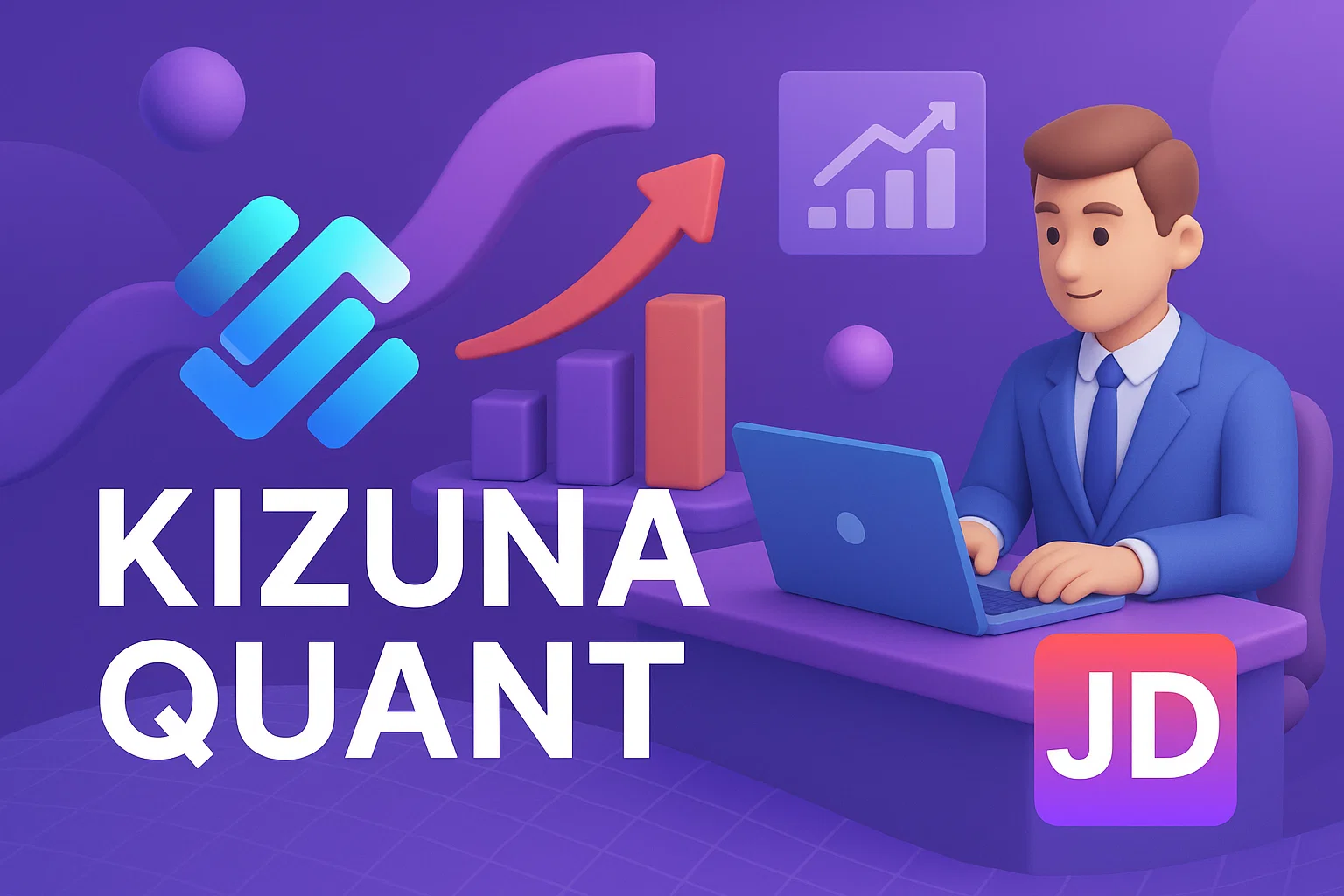


✅ Smart Automation Technology
✅ International Presence
Investing options:
4.2

Products, markets, & assets:
4.1

Deposits & withdrawals:
4.0

Fees & costs:
4.2

Platforms & usability:
4.4

Safety & reliability:
4.2

Research & analysis tools:
4.3

Education & learning resources:
4.3

| Best For | Traders seeking AI-driven automation, cross-market access, and educational support to enhance long-term strategy development. |
|---|---|
| Key Strengths |
Advanced AI automation
Multi-market trading (crypto, forex, stocks, commodities)
Strong security & GDPR compliance
Cross-platform usability
Comprehensive educational resources
|
| Notable Weaknesses |
Broker dependency affects consistency
No demo mode available
Limited transparency on instruments
|
| Bottom Line | Kizuna Quant earns a 4.3/5 rating for its real AI trading capabilities, multi-asset coverage, and user-focused learning tools. A powerful, evolving platform best suited for traders who value automation and education over full manual control. |

Kizuna Quant positions itself as a next-generation trading platform that combines AI technology with automated trading capabilities. After spending time analyzing its features and structure, I can say it offers a decent package for traders looking to automate their strategies. The platform’s modular architecture and multi-market approach make it stand out, though there are some areas where it could improve.
The ¥37,500 price point puts it in the mid-range category. Whether that’s worth it depends on what you’re looking for in a trading system.
Kizuna Quant covers a pretty wide range of markets. You’ve got cryptocurrencies, forex, commodities like oil and corn, precious metals (gold and silver), and stocks. The platform doesn’t lock you into just crypto or just forex, which is actually useful for portfolio diversification.
What I appreciate is the flexibility to switch between markets without needing separate accounts or platforms. However, the actual depth of offerings within each category isn’t fully transparent from the documentation. For instance, how many cryptocurrency pairs are available? Which stock exchanges do they connect to? These details matter when you’re making a decision.
The multi-asset approach gets points, but the lack of specifics about available instruments keeps this from being a perfect score.
The platform operates through partnered brokers, which means your actual trading conditions depend on who you’re matched with. This broker-dependency model is common in automated trading platforms, but it introduces variables you can’t control.
Kizuna Quant supports equities, FX pairs, commodities, and digital assets. The modular system architecture theoretically allows for expansion into new markets, which is forward-thinking. But here’s the thing – you need to verify your specific broker’s offerings independently.
Stock trading accessibility varies by region and broker. Commodity futures might have minimum contract sizes that don’t work for smaller accounts. The platform handles the technical side, but market access still depends on external factors.
The documentation doesn’t provide extensive detail on the deposit and withdrawal process, which is a notable gap. What we know is that the platform requires an initial deposit to activate trading, and fund management is handled through the partnered brokers.
This means deposit methods, withdrawal times, and minimum/maximum limits will vary. Some brokers might offer credit cards, e-wallets, and bank transfers. Others might be more restrictive. The lack of standardized information here is frustrating.
Processing times and any associated fees aren’t clearly outlined in the platform materials. You’ll need to clarify these details with your assigned broker after registration.
The upfront cost is ¥37,500, which is transparent. That’s for the platform access and AI system. Beyond that, you’re looking at broker-specific costs: spreads, commissions, overnight fees for leveraged positions, and possibly inactivity fees.
The platform itself doesn’t appear to charge per-trade fees on top of broker costs, which is reasonable. But calculating your total cost of ownership requires understanding both the platform fee and your broker’s fee structure.
One thing that’s unclear is whether there are ongoing subscription costs or if the ¥37,500 is a one-time payment. This ambiguity could trip people up.
Kizuna Quant runs on web browsers and has apps for Windows, macOS, iOS, and Android (version 7.1.2 to 13.0). Cross-platform accessibility is solid. You can monitor positions from your phone and manage settings from your desktop without issues.
The dashboard interface is designed to be intuitive. You get real-time market data, trading history, profit analysis, and strategy controls all in one place. The visual layout reportedly makes it easy to navigate even for beginners.
That said, automated trading platforms always have a learning curve. The system might be “user-friendly,” but understanding how to set proper risk parameters, leverage levels, and stop-loss points requires knowledge. The interface can be simple, but the decisions you make within it aren’t.
Mobile app functionality seems comprehensive, though some users might find the smaller screen limiting for detailed analysis.
Security gets serious attention. SSL/TLS encryption handles data transmission. User data lives on distributed cloud servers for redundancy. Two-factor authentication adds an account security layer. The platform claims GDPR compliance, which matters for European users.
Transaction logs are supposedly stored using blockchain technology for transparency and auditability. That’s interesting if true, though the implementation details aren’t fully explained.
The 85% success rate claim needs scrutiny. That’s a marketing figure, and success rates vary based on market conditions, chosen strategies, risk settings, and countless other variables. Your mileage will vary.
Broker vetting is mentioned but not detailed. Since you’re trading through third-party brokers, their reliability directly impacts your experience. The platform should provide clearer information about broker selection criteria.
Educational support includes video tutorials, FAQ sections, webinars, and detailed guides. The materials cover both platform-specific topics and general trading concepts. For someone new to automated trading, these resources help bridge the knowledge gap.
The community forum lets users share strategies and experiences. Expert guidance is available through the support team. The learning ecosystem seems legitimate and useful.
What’s missing is information about the depth and frequency of educational content. Are webinars weekly? Monthly? Are the video tutorials comprehensive or just basic overviews? Active learners will want to know.
The AI engine handles market analysis using deep learning and machine learning. It monitors thousands of indicators simultaneously and identifies entry/exit points based on price trends, volatility, and news events.
Multiple algorithm modules work together: short-term trend detection, volatility analysis, and risk assessment. The system supposedly learns from past trades to improve prediction accuracy over time.
Real-time market insights and trading signals come through the dashboard. You can backtest strategies against historical data, which is essential for validation.
However, the platform doesn’t offer traditional charting tools or technical indicators for manual analysis. If you want to dig into candlestick patterns or draw trendlines yourself, you might need external tools. The focus is clearly on AI-driven insights rather than manual technical analysis.
AI automation actually works – The deep learning approach to market analysis is sophisticated. Having a system that adapts and learns from data is valuable in constantly shifting markets.
Multi-market access – Trading crypto, forex, and commodities from one platform simplifies portfolio management. You’re not juggling multiple accounts.
Security infrastructure – SSL/TLS encryption, 2FA, distributed cloud storage, and GDPR compliance show they’re taking data protection seriously.
Cross-platform availability – Web, desktop, and mobile access means you can manage trades from anywhere. The flexibility is genuinely useful.
Educational commitment – The platform doesn’t just throw you into trading. The learning resources and community support help users develop skills.
Broker dependency – Your actual trading experience depends heavily on which broker you’re matched with. This introduces variables outside your control.
Limited transparency on costs – While the platform fee is clear, the full picture of ongoing costs requires digging into broker-specific terms.
No demo mode mentioned – Starting with real money without a practice environment is risky, especially for beginners.
Unclear specifics – Details about exact instrument offerings, deposit methods, and withdrawal processes are vague.
This platform makes sense if you’re interested in automated trading and want AI doing the heavy lifting. It’s appropriate for people who understand that trading carries risk but want technological assistance in decision-making.
If you value learning and want educational resources alongside automation, Kizuna Quant delivers. The community aspect and expert guidance create an environment for skill development.
For traders who need multi-market access and don’t want to manage multiple platforms, the consolidated approach is practical.
If you demand complete control and prefer manual analysis with traditional charting tools, this isn’t your platform. The AI-focused approach doesn’t cater to discretionary traders who want to draw their own conclusions.
People uncomfortable with broker-dependency models should probably pass. You need to be okay with not knowing your exact broker until after registration.
If you’re expecting guaranteed returns or believe the 85% success rate applies universally, adjust your expectations or don’t proceed. Trading doesn’t work that way.
Kizuna Quant earns a 4.3/5 rating. It’s a competent automated trading platform with legitimate AI capabilities, solid security, and multi-market access. The educational resources and community support add value beyond just the trading system itself.
The ¥37,500 price is reasonable for what you’re getting, assuming you understand that broker fees will add to the total cost. The technology is genuinely advanced, and the multi-layered architecture suggests ongoing development potential.
If you’re willing to do additional due diligence on broker selection and understand the inherent risks of automated trading, Kizuna Quant is worth considering. Just don’t expect miracles, and be prepared to learn as you go.
The platform delivers on its core promise of AI-assisted trading across multiple markets. Whether it’s the right fit depends on your trading goals, risk tolerance, and willingness to work within its structure.
Bottom line: A strong option in the automated trading space, but not without limitations. Do your homework, understand the risks, and approach with realistic expectations.
All content on JD Forex Broker is carefully verified by our editorial team to meet strict accuracy and transparency standards. The information presented here is backed by the following trusted sources.
JD Forex Broker offers independent reviews and educational content only. We do not provide financial advice. Trading and investing in forex, stocks, crypto, or commodities carries risk, and you should never invest more than you can afford to lose.
Adam Fent is a forex trader who has been involved in the markets since he was a teenager. He started out by day trading penny stocks, and eventually transitioned to Forex because of its liquidity and 24-hour nature.
He has been consistently profitable for the past several years, and is always looking to improve his trading skills. When he's not trading, he enjoys spending time with his wife and two young children.